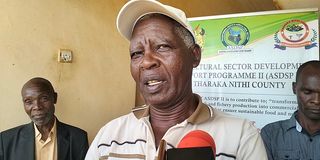Tighten your belts, weatherman tells residents of semi-arid parts of Tharaka

Kenya Meteorological Department Tharaka-Nithi County director Mr Justin Murithi during a press conference at Chuka town in Tharaka-Nithi County.
Residents of the semi-arid parts of Tharaka North sub-county bordering Meru National Park and Tana River have been asked to prepare for low rainfall for the March-May period.
In a joint statement to the media Tuesday, Kenya Meteorological Department Tharaka Nithi county director, Mr Justin Murithi and county lead traditional weather forecaster Japhet Kithuci agreed that areas bordering Mt Kenya Forest, including Chuka and Chogoria, will receive enough rainfall.
They said the rainfall is expected to start from next week and stop between the third and fourth week of May, with the upper side of the forest receiving 500mm to 600mm and the lowest areas of Kimiramba and Kathangacini receiving 200mm and below.
“The areas bordering Mt Kenya forest will receive normal rainfall, which will be enough for crop maturity and the lower sides bordering Meru National Park and Tana River will receive below average rainfall not sufficient for crop maturity,” said Mr Murithi.
Signs of rainfall
Mr Kithuci said signs of the coming rain include flowering of some trees, movement of elephants from the deep forest to the border of villages and the position of the moon and some stars clearly show that the onset of rain is near.

A traditional weather forecaster Mr Japhet Kithuci during a press conference at Chuka town in Tharaka-Nithi County.
He explained that elephants give birth during the wet season and when the rain is about to fall, they move to the Gaketha “elephant maternity” which borders the villages of Mitheru ward, where the land is flat and also where they can get clay soil to smear on their newborns to protect them from tsetse flies and other biting insects.
Mr Kithuci said the deep thick forest is also ‘very’ cold during the rainy season and is not conducive for the elephant calves.
The other sign of impending rain is the colour of the sun when rising and setting is reddish and some stars are at some particular positions.
“Though we don’t work with figures like the meteorological scientists, we observe the flowering of some plants, movement of animals and insects, and the position of moon and stars to tell when it is about to rain and whether the rain will be enough for crop maturity,” said Mr Kithuci.
Caritas, the social development arm of the Catholic Diocese of Meru Tharaka Nithi County head of Programmes, Mr Joel Kithure urged the farmers to plant early maturity crops such as green grams, especially in the lower parts of Tharaka constituency, to avoid total crop failure.
He also asked the county government to disperse agricultural extension officers to the villages to guide the farmers on the right seeds for planting in the various ecological zones.
“We have to help our farmers to make the right decisions on the crop to plant at various zones to avoid total crop failure,” said Mr Kithure.
He said for the last several rainy seasons, the semi-arid areas of Tharaka North Sub-County have not received enough rainfall, resulting in hunger for both people and livestock.





